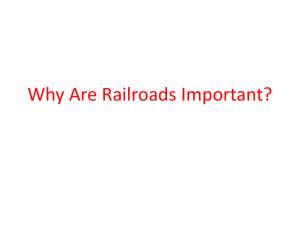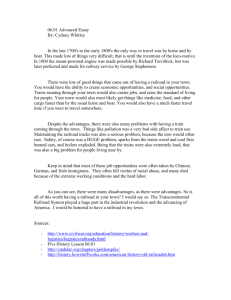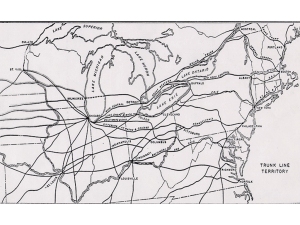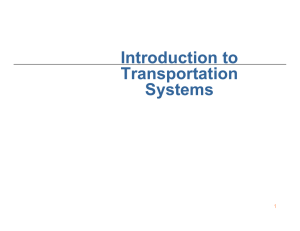Document 13504064
advertisement
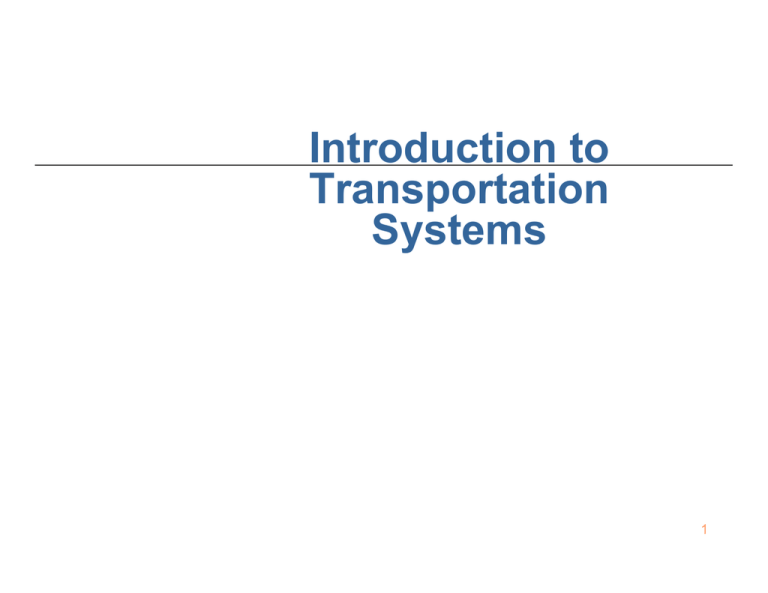
Introduction to Transportation Systems 1 PART II: FREIGHT TRANSPORTATION 2 Chapter 14: Railroad Operations 3 Path from Shipper to Receiver Shipper Local Train A Train AB B Train BC Train EB E C Local Train Train BD Receiver D F 4 Blocking Patterns Train AB E D C Train BD B D+F D and F randomly ordered Train EB A D C Train BC or B F D D and F traffic is blocked C 5 Consolidation A Key Concept: Consolidation The railroad system is a high fixed cost system. Take traffic from E and A destined for C and block it into a single set of cars that will go together from B to C at presumably lower cost than in the case of A-C and E-C traffic going separately. 6 Train Operating Costs vs. Train Length Train Operating Costs additional power Train Length (cars) Figure 14.3 7 The operating policy to generate cost savings through consolidation implies stiff penalties when things go wrong. The reason that we run only one train a day from B to C is to achieve long train lengths. Often we operate with 24-hour service headways; if the cars from E to B destined for this outbound train going to C misses that connection for whatever reason, this can cause a 24-hour delay until the next train. Think about the impact of these delays on the total logistics costs of the affected receivers. Perhaps a stock-out for our customer results. 8 Cost/Car and Train Length Cost/Car Train Length (cars) The cost per car on a long train is clearly going to be much lower than the cost per car on a short train. So there is an incentive to run longer trains from a cost view; that is what drives the idea of low train frequency. If we run two trains a day between B and C with 50 cars on each rather than 1 train with 100 cars, there is a higher level-of-service associated with a higher train frequency; however, from a cost point of view it is more expensive to run two 50-car trains rather than one 100car train. Figure 14.4 9 Operations vs. Marketing Perspectives Now this simple idea relates to “tension” between the operating and the marketing people. Who is going to want to run the 100-car train? The operating person or the marketing person? And who is going to want to run the two 50-car trains? CLASS DISCUSSION 10 Train Dispatching Dispatching Choices A Train AB B Train BC C Train EB E C’ A Train CC’ B E Train BC C Train CC’’ C’’ Train CC’’’ C’’’ Figure 14.5 11 A Choice in Dispatching Do We “Hold for Traffic”? 12 Delay Propagation on Networks Network Stability Stable vs. Unstable Equilibrium Stable Equilibrium Figure 14.6 Unstable Equilibrium 13 Operating Plan Integrity Why don’t the railroads just run the trains on schedule as an optimal strategy? The basic notion is design an operating plan that is feasible and makes sense. You have enough power; you have enough line capacity; you have enough terminal capacity to make this plan actually work. You run the trains according to plan, that is, according to schedule. 14 “Scheduled” vs. “Flexible” Operation Is the best strategy “running to plan” in a disciplined manner? Some railroads feel that is an inflexible, uneconomic way of running the system. These railroads feel that flexibility for the terminal managers is useful and they can do a better job of balancing service and costs than they can by inflexibly “running to plan”. 15 A Framework for Transportation Operations Operating Plan Stochastic Conditions Philosophy Daily Modified Operating Plan 16 “Daily Modified Operating Plan” Suppose we have developed, through optimization methods, an “operating plan” which governs the network. Suppose each day at 6 a.m., railroad management takes that operating plan and from it produces a daily modified operating plan which governs the way the railroad will operate on that particular day. The operating plan is a base case; the daily modified operating plan is a plan of action for a particular day. The daily modified operating plan takes account of stochastic conditions on the network like weather and traffic conditions. It also reflects how much a railroad is willing to change that base operating plan to accommodate conditions on a particular day. 17 How to Define Scheduled vs. Flexible Railroads? The first way: A scheduled railroad would be one in which the operating plan and the daily modified operating plan were exactly the same. The second way: A scheduled railroad is one in which there is no difference between the daily modified operating plan decided upon at 6 a.m. and what they actually do that day. 18
